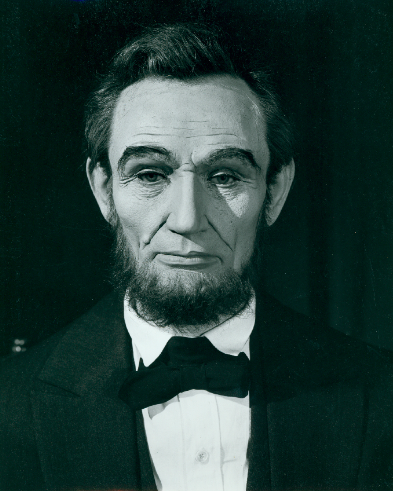As another Presidents Day rolled by this February, so do the appropriately themed discounts on new cars and ideas on how to spend the three-day weekend. While those things are certainly nice, they can crowd out the true meaning of the holiday – to commemorate the achievements and sacrifices made by America’s chief executives, particularly George Washington and Abraham Lincoln. Although Presidents Day was established after Walt’s time, he appreciated this sentiment and he incorporated it into a new attraction titled Great Moments with Mr. Lincoln. Here’s a closer look at how the idea for this show came about, what the process to create it was like, and how it became successful.
 The idea for Great Moments with Mr. Lincoln coalesced from experiences in Walt’s youth and his instincts as a businessman. While growing up in Missouri, one of Walt’s childhood heroes was Abraham Lincoln. His admiration for the sixteenth president was on full display when, for a school project, he donned a homemade stovepipe hat and recited the Gettysburg Address from memory in front of his class. His performance was so well received that he was asked to give encores for the other classes in the school. The memory of this triumphant experience stayed with Walt for decades and it eventually dovetailed with his desire to create new attractions for Disneyland, even after the park had opened. The result was an idea named "One Nation Under God," a theater show featuring an original film about American history and a hall filled with lifelike figures of every U.S. president. Faced with the monumental task of building (at the time) thirty-four mechanical figures, Walt had his Imagineers start with Lincoln. As development on the attraction progressed, a fateful meeting occurred. The head of the World’s Fair being planned for New York in 1964, Robert Moses, came by to tour the Disney Studio. Walt saw the fair as an opportunity to try out new attractions slated for Disneyland and to test the waters for an East Coast theme park. When they came across the plans for "One Nation Under God," Robert was so impressed that he insisted on including the attraction at the fair. Walt was pleased, but conceded that there was not enough time before the fair’s opening to complete the entire show. Thus, the idea was revised to focus on Lincoln exclusively.
The idea for Great Moments with Mr. Lincoln coalesced from experiences in Walt’s youth and his instincts as a businessman. While growing up in Missouri, one of Walt’s childhood heroes was Abraham Lincoln. His admiration for the sixteenth president was on full display when, for a school project, he donned a homemade stovepipe hat and recited the Gettysburg Address from memory in front of his class. His performance was so well received that he was asked to give encores for the other classes in the school. The memory of this triumphant experience stayed with Walt for decades and it eventually dovetailed with his desire to create new attractions for Disneyland, even after the park had opened. The result was an idea named "One Nation Under God," a theater show featuring an original film about American history and a hall filled with lifelike figures of every U.S. president. Faced with the monumental task of building (at the time) thirty-four mechanical figures, Walt had his Imagineers start with Lincoln. As development on the attraction progressed, a fateful meeting occurred. The head of the World’s Fair being planned for New York in 1964, Robert Moses, came by to tour the Disney Studio. Walt saw the fair as an opportunity to try out new attractions slated for Disneyland and to test the waters for an East Coast theme park. When they came across the plans for "One Nation Under God," Robert was so impressed that he insisted on including the attraction at the fair. Walt was pleased, but conceded that there was not enough time before the fair’s opening to complete the entire show. Thus, the idea was revised to focus on Lincoln exclusively.To make the idea a reality, Walt’s Imagineers relied on priceless historical artifacts and their own technological breakthroughs. In crafting the appearance of the figure, photographs of the actual man were used, as well as a life mask of Lincoln’s face made by renowned sculptor Leonard Volk in 1860. As the appearance took shape, a group of Imagineers were tasked with bringing the mechanical figure to life. Their solution was a new form of robotics called Audio-Animatronics. Technically, this system used hydraulic and pneumatic valves to move the different parts of the figure. Conceptually, one way to understand Audio-Animatronics is to consider a player piano. An instrument that plays on its own, a player piano relies on a paper roll that is indented with markings. Each marking indicates which musical note needs to be played and at what time. When the roll turns, the markings trigger mechanisms in the piano that play the keys, which sound the specified note. The result is a song being heard. For Audio-Animatronics, instead of markings indented on a paper roll, there are tones recorded on a magnetic tape. Each tone indicates which part of the figure needs to move and at what time. When the tape is played, the tones send electrical signals to the appropriate valves, which bring Lincoln to life in a symphony of movement. Recording those tones was a challenge by itself. Imagineer Wathel Rogers spent many hours in a harness built to record specific body movements. He had to act out the precise arm waves, hand gestures, and other movements that he wanted the Lincoln figure to perform, from the start of the show to its finish. Through these efforts, Great Moments with Mr. Lincoln was made a reality.
Enabling the show’s success was made possible through Walt standing by his own convictions. He was put to the test shortly after the Lincoln figure failed to operate correctly upon being installed at the fairgrounds in New York. Despite round-the-clock efforts by the Imagineers, the figure continued to have problems the night of a preview for five hundred dignitaries from the State of Illinois, which was the attraction’s sponsor. Instead of raising the curtain and hoping for the best, Walt decided to cancel the performance and he went out on stage to inform a disappointed audience himself. In doing so, he conveyed his belief in putting on the best show possible or no show at all. This conviction had guided Walt’s previous successes including procuring the best sound recording technology for Mickey Mouse’s theatrical debut and producing the highest quality animated feature in Snow White and the Seven Dwarfs. In both of these examples, Walt’s approach paid off, as it would with Great Moments with Mr. Lincoln. Shortly after the preview night, the Imagineers got the Lincoln figure to perform perfectly and the Illinois pavilion became one of the most popular attractions at the fair. As the World’s Fair entered its final months, a duplicate Lincoln figure took up residence at the Opera House in Disneyland. Through the years and a few mechanical upgrades, he continues to dazzle and inspire guests to this day.
Overall, Great Moments with Mr. Lincoln not only allowed Walt a chance to pay tribute to his hero but also an opportunity to expand the horizons of the entertainment field with the advent of Audio-Animatronics. New attractions, like Walt Disney World’s The Hall of Presidents, were made possible with this breakthrough, allowing guests more enjoyment and a way to celebrate the true meaning of Presidents Day.

Jeffrey Moffit
Visitor Services Associate
at The Walt Disney Family Museum
